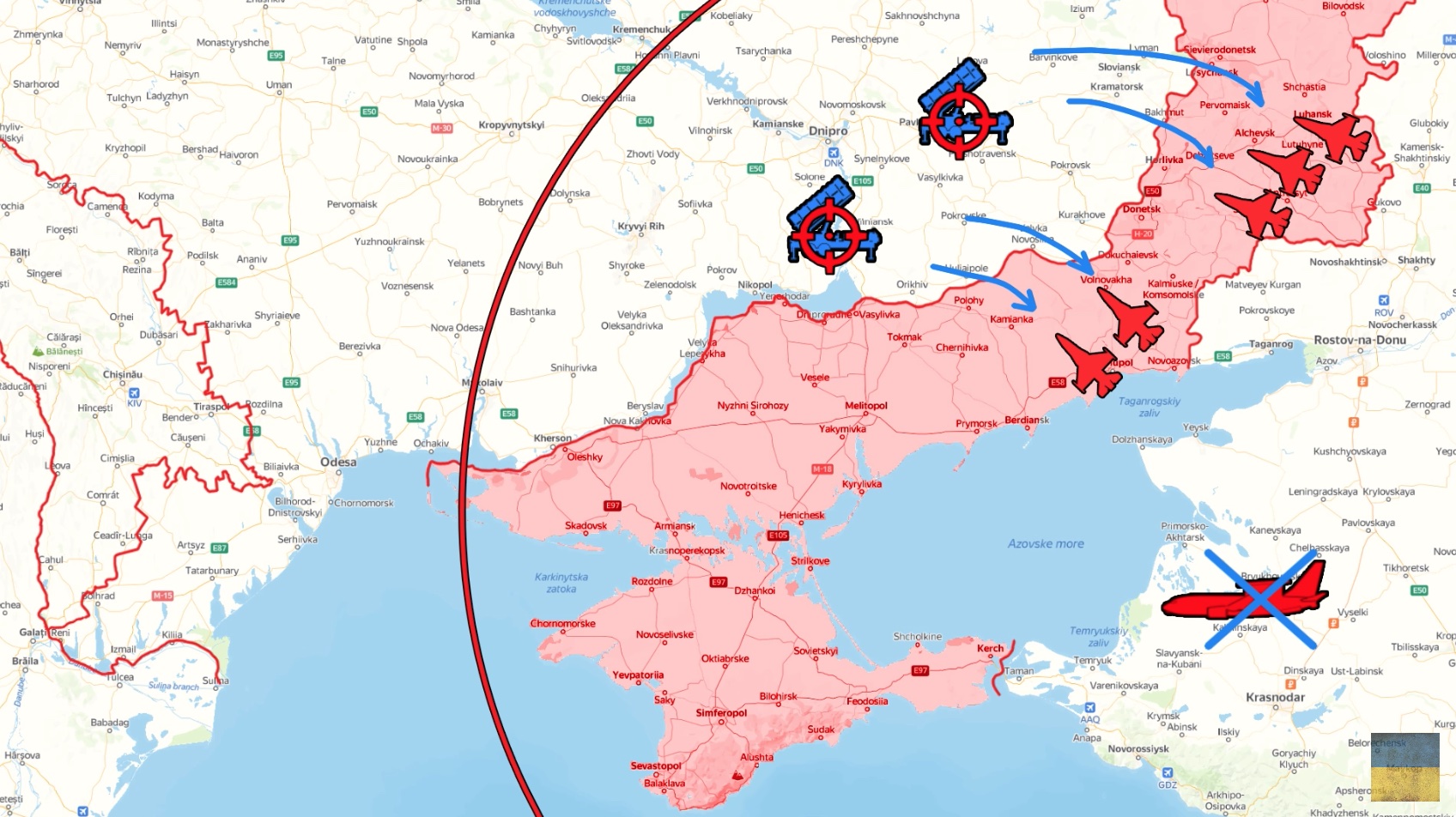Today, there are a lot of interesting news.
First of all, the Russian Armed Forces suffered a strategically significant loss of an A-50U Airborne Early Warning and Control aircraft. This is already the second A-50 aircraft that Russians lost just over the last two months.
For context, the radar on this aircraft helps Russians detect virtually any object within a 600-kilometer radius.

The Russians had only a handful of such game-changing pieces of technology that allow them to assert local air superiority.
Today, the number of A-50 aircraft in the Russian arsenal has been reduced to seven, and with the current rate of losses, Russians will completely run out of them in just half a year. What makes the situation even worse is that Russians basically cannot produce new A-50 aircraft due to sanctions.

The incident happened near the Azov Sea, which is quite interesting because the last A-50 was shot down here as well.
If you still remember, Ukrainian forces significantly depleted Russian detection and surveillance capabilities in Crimea by conducting an extensive series of strikes in January, which resulted in the destruction of multiple radar stations.
Frontline report: Months of strikes set stage for latest missile onslaught on Crimea
In order to compensate for the lack of radars, Russians started to deploy A-50 to close the sky. However, the aircraft got within Patriot air defense system range and was promptly intercepted.

This time, the Russian aircraft was intercepted more than 250 kilometers away from the front line, which is outside the 150-kilometer range of Patriot systems. This raised a lot of questions and speculations regarding the mysterious interception.
Friendly fire downed the A-50?
Russian sources reported that at the moment of the incident, the Russian air defense system was busy intercepting two missiles that Ukrainians launched from the Dnipro area. Due to the fact that the trajectories of the missiles and the A-50 aircraft were close, the Russian air defense operators reportedly got confused, thought the A-50 aircraft was also a missile, and shot it down.

The proponents of this version of events claim that the Russian air defense has had many such instances in the past. The critics of this theory claim that judging by the speed and size of the massive A-50 aircraft, it is impossible to confuse it with the missile, especially given that this aircraft is basically a flying radar that gives information to the air defense operators.
Moreover, the aircraft had just taken off and was steadily gaining speed and altitude, and it was also moving away from Russia, not toward it. The critics also said that they do not believe that all six aircraft in the last two months were lost due to friendly fire and noted that throughout this two-year war, 75% of all Russian aircraft losses were reported as friendly fire accidents.

The critics speculated that the aircraft was shot down by the sabotage groups with man-portable air defense systems that were operating on the territory of the Russian Federation.
Ukrainian sources reported that the A-50 aircraft’s interception resulted from a successful operation by the Ukrainian Air Force and Special Forces. The Spokesman for the Ukrainian Main Intelligence Directorate reported that Ukrainians used modified S-200 air defense systems to identify and destroy the target.

Even though the S-200 missile was developed in the Soviet Union, Ukrainians have reportedly modernized them to the point where the only common thing between them and their old counterparts is the carcass.
Regardless of which version is correct, the destruction of the scarce A-50 aircraft is expected to bring temporary relief from bombardments on the front.
As the A-50 can track up to 60 targets simultaneously, it provided excellent cover for the Russian fighter-bombers from the possible retaliation from the Ukrainian air defense.

Russian forces established and enjoyed this local air superiority the most in the Avdiivka direction, where they have been dropping up to 60 bombs per day during the peak heat of the Battle for Avdiivka.
According to both Ukrainian and Russian sources, even though the use of bombs significantly decreased after Russians lost five fighter-bombers, the bombardments did not cease completely.
As mentioned previously, the next main Ukrainian defense line is north of the small river, which made it ambiguous whether Ukrainians would try to retain control over the four small villages south of this river or withdraw to the prepared defenses.
Today, it became clear that Ukrainians plan to gradually withdraw to the main defense line because, as the fighters reported, the tall residential buildings in the southern part of Avdiivka and the tall infrastructure on the territory of the chemical plant make Ukrainian positions in the immediate proximity simply untenable.
This, coupled with bombardments, forced Ukrainians to withdraw from the first village in this area. However, with the loss of the A-50 aircraft, the Russian fighter bombers became extremely vulnerable, reducing their activity in the region. Without bombardments, Ukrainian forces can put up resistance in the current setting, especially from the positions closer to the river.

Based on the recently released geolocated combat footage, Russian forces have already lost multiple assault units in their attempts to capitalize on the recent events and collapse the front line. Ukrainian fighters from the third assault brigade showed that Russians even started using mechanized assault units, so far, to no avail.
Close coordination with artillery crews allowed Ukrainians to repel the attack and even take captives.
In our daily frontline report, we pair up with the military blogger Reporting from Ukraine to keep you informed about what is happening on the battlefield in the Russo-Ukrainian war.
Related:
- This is what can fix Ukraine’s Russian gliding bomb predicament
- Ukraine intel discloses details of A-50 downing: five more Russian aircraft were recalled




